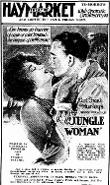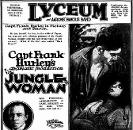AustLit
The material on this page is available to AustLit subscribers. If you are a subscriber or are from a subscribing organisation, please log in to gain full access. To explore options for subscribing to this unique teaching, research, and publishing resource for Australian culture and storytelling, please contact us or find out more.
Latest Issues
AbstractHistoryArchive Description
'Gold that lures men to the utter most recesses of the earth, in the elusive search for happiness and wealth, for wealth means happiness according to the creed of the earth! Captain Hurley's wonderful story of Southern Isles is based on this time honoured theme of the lure of the glittering metal and the dangers risked by those engaged in their relentless search for power. Two young Englishmen are lured to the wild interior of New Guinea, there to be thrown into a breathless struggle.'
Source:
'The Jungle Woman', Goulburn Evening Penny Post, 9 July 1926, p.4 (via Trove Australia).
Publication Details of Only Known VersionEarliest 2 Known Versions of
Works about this Work
-
Sweet Dreams : Queensland, Sugar and the 1927 Royal Commission into the Moving Picture Industry
2011
single work
criticism
— Appears in: Studies in Australasian Cinema , 24 August vol. 5 no. 2 2011; (p. 107-119) 'The impetus for the 1927 Royal Commission into the Moving Picture Industry was the US film companies' 'stranglehold' on the Australian film industry, the effects of which were perceived as undermining both Australian film businesses and Australian national identity. The Commissioners took evidence in seven Queensland towns, some quite small and isolated, with almost all exhibitors from these locations represented. This evidence constructs an in-depth picture of film business and consumption in regional Australia, as well as a social, cultural and economic portrait of the country on the cusp of the Great Depression. This article takes as its starting point the Commissioners' repeated comparison of the film industry and Queensland's sugar industry, and their suggestions that the film industry's problems could be solved by replicating the intervention and support given to the sugar industry by both State and Federal Governments. These references, the article argues, reveal the Commissioners' understanding of the film industry, and conjectures that these conceptualizations may still influence the way Australian films are watched today.' (Editor's abstract)
-
Sweet Dreams : Queensland, Sugar and the 1927 Royal Commission into the Moving Picture Industry
2011
single work
criticism
— Appears in: Studies in Australasian Cinema , 24 August vol. 5 no. 2 2011; (p. 107-119) 'The impetus for the 1927 Royal Commission into the Moving Picture Industry was the US film companies' 'stranglehold' on the Australian film industry, the effects of which were perceived as undermining both Australian film businesses and Australian national identity. The Commissioners took evidence in seven Queensland towns, some quite small and isolated, with almost all exhibitors from these locations represented. This evidence constructs an in-depth picture of film business and consumption in regional Australia, as well as a social, cultural and economic portrait of the country on the cusp of the Great Depression. This article takes as its starting point the Commissioners' repeated comparison of the film industry and Queensland's sugar industry, and their suggestions that the film industry's problems could be solved by replicating the intervention and support given to the sugar industry by both State and Federal Governments. These references, the article argues, reveal the Commissioners' understanding of the film industry, and conjectures that these conceptualizations may still influence the way Australian films are watched today.' (Editor's abstract)
Last amended 21 Aug 2014 15:48:26
Settings:
-
cPapua New Guinea,cPacific Region,
Export this record





